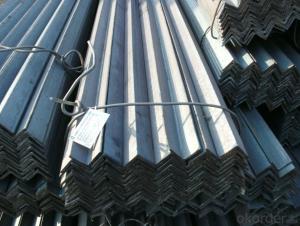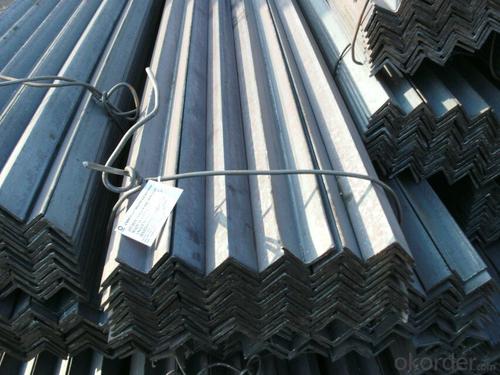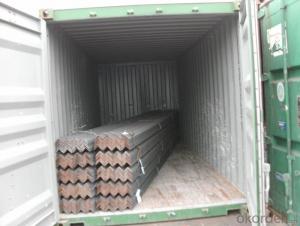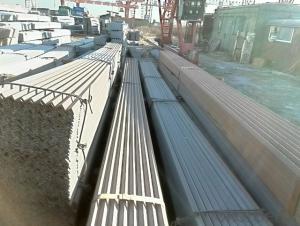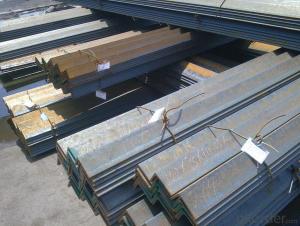Supply High Quality Hot Rolled Angle Steel to Kenya
- Loading Port:
- Tianjin
- Payment Terms:
- TT OR LC
- Min Order Qty:
- 25 m.t.
- Supply Capability:
- 20000 m.t./month
OKorder Service Pledge
OKorder Financial Service
You Might Also Like
Specification
OKorder is offering high quality Hot Rolled Steel Angle at great prices with worldwide shipping. Our supplier is a world-class manufacturer of steel, with our products utilized the world over. OKorder annually supplies products to European, North American and Asian markets. We provide quotations within 24 hours of receiving an inquiry and guarantee competitive prices.
Product Applications:
Hot Rolled Steel Angles are ideal for structural applications and are widely used in the construction of buildings and bridges, and the manufacturing, petrochemical, and transportation industries.
Product Advantages:
OKorder's Steel Angles are durable, strong, and resist corrosion.
Main Product Features:
· Premium quality
· Prompt delivery & seaworthy packing (30 days after receiving deposit)
· Corrosion resistance
· Can be recycled and reused
· Mill test certification
· Professional Service
· Competitive pricing
Product Specifications:
Manufacture: Hot rolled
Grade: Q195 – 235
Certificates: ISO, SGS, BV, CIQ
Length: 6m – 12m, as per customer request
Packaging: Export packing, nude packing, bundled
Sizes: 25mm-250mm | ||
a*t | ||
25*2.5-4.0 | 70*6.0-9.0 | 130*9.0-15 |
30*2.5-6.6 | 75*6.0-9.0 | 140*10-14 |
36*3.0-5.0 | 80*5.0-10 | 150*10-20 |
38*2.3-6.0 | 90*7.0-10 | 160*10-16 |
40*3.0-5.0 | 100*6.0-12 | 175*12-15 |
45*4.0-6.0 | 110*8.0-10 | 180*12-18 |
50*4.0-6.0 | 120*6.0-15 | 200*14-25 |
60*4.0-8.0 | 125*8.0-14 | 250*25 |
FAQ:
Q1: Why buy Materials & Equipment from OKorder.com?
A1: All products offered byOKorder.com are carefully selected from China's most reliable manufacturing enterprises. Through its ISO certifications, OKorder.com adheres to the highest standards and a commitment to supply chain safety and customer satisfaction.
Q2: How do we guarantee the quality of our products?
A2: We have established an advanced quality management system which conducts strict quality tests at every step, from raw materials to the final product. At the same time, we provide extensive follow-up service assurances as required.
Q3: How soon can we receive the product after purchase?
A3: Within three days of placing an order, we will begin production. The specific shipping date is dependent upon international and government factors, but is typically 7 to 10 workdays.
Alloy No | Grade | Element (%) | ||||
C | Mn | S | P | Si | ||
Q235 | B | 0.12—0.20 | 0.3—0.7 | ≤0.045 | ≤0.045 | ≤0.3 |
Alloy No | Grade | Yielding strength point( Mpa) | ||||
Thickness (mm) | ||||||
≤16 | >16--40 | >40--60 | >60--100 | |||
≥ | ||||||
Q235 | B | 235 | 225 | 215 | 205 | |
Alloy No | Grade | Tensile strength (Mpa) | Elongation after fracture (%) | |||
Thickness (mm) | ||||||
≤16 | >16--40 | >40--60 | >60--100 | |||
≥ | ||||||
Q235 | B | 375--500 | 26 | 25 | 24 | 23 |
Images:

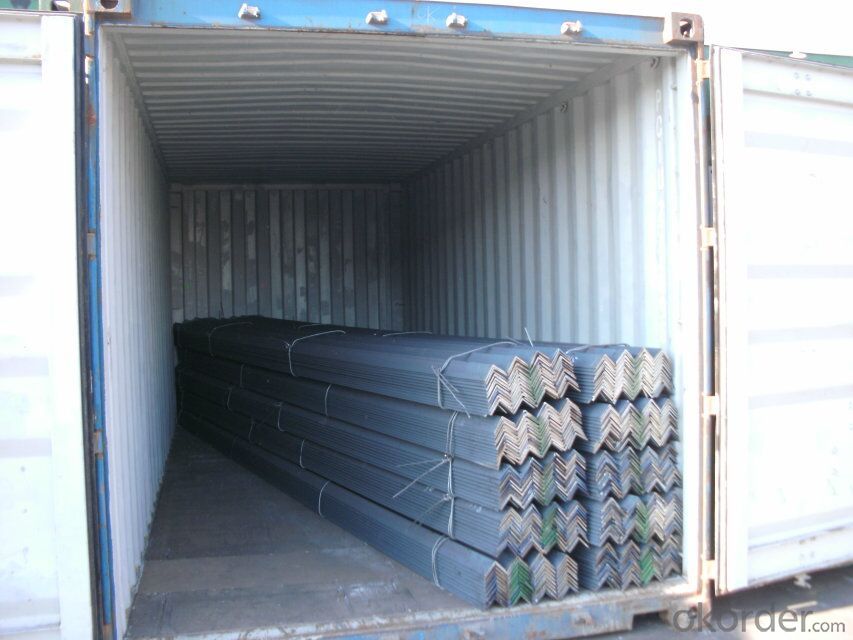
- Q: What are the welding techniques used for steel angles?
- Different welding techniques can be used for steel angles, depending on the specific application and desired result. Some commonly used techniques include: 1. Stick welding, also known as Shielded Metal Arc Welding (SMAW), involves using a consumable electrode coated in flux. It is versatile, cost-effective, and suitable for various thicknesses of steel angles. 2. Gas Metal Arc Welding (GMAW), also known as MIG (Metal Inert Gas) welding, utilizes a welding gun to feed a wire electrode. The wire melts and joins with the base metal, while an inert gas shield protects the weld from contamination. GMAW is commonly used for thin to medium thickness steel angles. 3. Flux-Cored Arc Welding (FCAW) is similar to GMAW, but the wire electrode is filled with flux, eliminating the need for external shielding gas. FCAW is suitable for both indoor and outdoor applications and is known for its high deposition rates. 4. Tungsten Inert Gas Welding (GTAW), also known as Gas Tungsten Arc Welding (GTAW), involves using a non-consumable tungsten electrode and a separate filler metal if necessary. This technique produces precise, high-quality welds and is commonly used for thinner steel angles or when precise control is required. 5. Submerged Arc Welding (SAW) uses a continuously fed wire electrode submerged in a granular flux. The flux acts as a protective layer, preventing contamination and enhancing weld quality. SAW is commonly used for thicker steel angles or when high deposition rates are needed. When selecting the appropriate welding technique, it is important to consider factors such as the thickness of the steel angles, the welding environment, and the desired quality and strength of the weld. Consulting with a professional welder or engineer can help determine the best technique for a specific application.
- Q: Can steel angles be used in storage rack systems?
- Yes, steel angles can be used in storage rack systems. Steel angles provide strength and stability, making them suitable for supporting heavy loads in storage racks. They can be used to create the framework and support beams in the rack system, ensuring durability and safety.
- Q: What are the different surface finishes for steel angles?
- Some of the different surface finishes for steel angles include mill finish, hot-dip galvanized, powder coated, and painted finishes.
- Q: How do you determine the deflection of a steel angle?
- To determine the deflection of a steel angle, you need to consider various factors such as the applied load, the moment of inertia of the angle, the length of the span, and the modulus of elasticity of the steel. By utilizing the appropriate formulas and equations for deflection, such as the Euler-Bernoulli beam theory, you can calculate the deflection of the steel angle under the given load and conditions.
- Q: Are steel angles resistant to extreme weather conditions?
- Known for their durability and strength, steel angles are highly resistant to extreme weather conditions. Typically made from hot-rolled steel, which possesses excellent weathering properties, these angles exhibit a high tensile strength and can endure harsh conditions like heavy rainfall, high winds, and extreme temperatures. Additionally, steel angles possess corrosion-resistant properties, enabling them to withstand exposure to moisture and humidity without rusting or deteriorating. This characteristic makes them ideal for outdoor applications where they may encounter rain, snow, or other environmental factors. Moreover, steel angles offer exceptional stability and maintain their shape and structural integrity even under the harshest weather conditions. They are specifically designed to provide support and stability to structures, rendering them perfect for use in buildings, bridges, and other infrastructure projects that need to withstand hurricanes, earthquakes, or other severe weather events. In summary, steel angles are an exceptional choice for applications that demand resistance to extreme weather conditions. Their strength, durability, and corrosion resistance make them a dependable and long-lasting alternative for outdoor structures.
- Q: Can steel angles be used in the construction of hotels?
- Yes, steel angles can be used in the construction of hotels. Steel angles are commonly used in construction for their strength and versatility. They can be used for structural support, framework, and reinforcement in various applications, including hotels. Their ability to withstand heavy loads and provide stability makes them a suitable choice in hotel construction projects.
- Q: What is the maximum bending moment for a steel angle?
- The maximum bending moment for a steel angle depends on various factors such as the dimensions and properties of the angle, the applied load, and the support conditions. In general, the maximum bending moment occurs at the location where the angle experiences the highest stress due to the applied load. To determine the maximum bending moment for a steel angle, one needs to consider the angle's section modulus (a measure of its resistance to bending), the distance between the applied load and the support, and the magnitude and distribution of the load. The section modulus is calculated based on the angle's dimensions, including its thickness, height, and width. By analyzing the applied load and the support conditions using principles of structural mechanics, engineers can determine the maximum bending moment for a steel angle. This information is crucial for designing and assessing the structural integrity of steel angle components in various applications, such as construction, manufacturing, and infrastructure projects. It is important to note that the maximum bending moment can vary significantly depending on the specific angle's dimensions, material properties, and the applied load. Therefore, it is necessary to consult relevant design codes, standards, or consult a qualified structural engineer for accurate and detailed calculations specific to a particular steel angle.
- Q: Can steel angles be used for window frames?
- Indeed, window frames can be constructed using steel angles. Owing to their robustness and endurance, steel angles find widespread application in the construction sector. They offer exceptional structural reinforcement and can endure substantial weight, rendering them suitable for window frames. Moreover, steel angles can be readily fabricated and tailored to accommodate specific window dimensions and contours. Furthermore, they possess excellent resistance to corrosion, guaranteeing durability and reducing the need for frequent maintenance. Consequently, steel angles emerge as a favored option for window frames across diverse settings, encompassing commercial structures, residential dwellings, and industrial establishments.
- Q: Can steel angles be used for platform structures?
- Yes, steel angles can be used for platform structures. Steel angles are commonly used in construction for their strength, durability, and versatility. They provide structural support and stability to various types of platforms, including elevated walkways, mezzanines, catwalks, and scaffolding. Steel angles offer excellent load-bearing capacity and can withstand heavy loads, making them suitable for platform structures that require a high level of strength and stability. Additionally, steel angles can be easily fabricated and joined together, allowing for efficient construction and customization of platform structures.
- Q: Can steel angles be used in railway infrastructure?
- Yes, steel angles can be used in railway infrastructure. They are commonly used in the construction of railway tracks, bridges, and other structures due to their high strength, durability, and ability to withstand heavy loads. Steel angles provide structural support and stability, making them an essential component in railway infrastructure projects.
Send your message to us
Supply High Quality Hot Rolled Angle Steel to Kenya
- Loading Port:
- Tianjin
- Payment Terms:
- TT OR LC
- Min Order Qty:
- 25 m.t.
- Supply Capability:
- 20000 m.t./month
OKorder Service Pledge
OKorder Financial Service
Similar products
Hot products
Hot Searches
Related keywords
